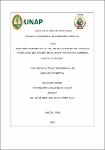Anatomía comparativa del xilema de la rama de dos especies forestales del arboretum el huayo en Puerto Almendra, Loreto-Perú, 2022
Abstract
In the present study, the macroscopic and microscopic description and comparison of the xylem of the branch of Tovomita krukovii A. C. Sm "chullachaqui caspi" and Remijia pedunculata (H. Karst.) Flueck "cascarilla" was carried out. The branch samples were collected in the Arboretum "El Huayo" of CIEFOR Puerto Almendra, and then taken to the Laboratory of Anatomy and Wood Technology of the FCF of the UNAP. Similar and differentiating anatomical characteristics were determined and the xylem of the branch of both species was classified. For this work, the procedure indicated by Valderrama (1986) and IAWA (1989) was followed for the preparation of histological slides and individual cells and their anatomical description. Similar and different characteristics were found in the branch xylem of the two species, with 40.5% of similar characteristics. Of the total quantitative anatomical features evaluated statistically at 95% probability, 63% of these features had significant differences. En el presente estudio se realizó la descripción macroscópica y microscópica, y comparaciones del xilema de la rama de Tovomita krukovii A. C. Sm “chullachaqui caspi” y Remijia pedunculata (H. Karst.) Flueck “cascarilla”. Las muestras de las ramas fueron colectadas en el Arboretum “El Huayo” del CIEFOR Puerto Almendra, y luego llevadas al Laboratorio de Anatomía y Tecnología de la Madera de la FCF de la UNAP. Se determinaron las características anatómicas similares y diferenciativas y se clasifico el xilema de la rama de ambas especies. Para este trabajo se siguió el procedimiento indicadas por Valderrama, (1986) y IAWA (1989), para la preparación de láminas histológicas y células individuales y su descripción anatómica. Se encontraron características similares y diferentes en el xilema de la rama de las dos especies, con un 40.5% de características similares. Del total las características anatómicas cuantitativas evaluadas estadísticamente al 95% de probabilidad, el 63% de estas características tuvieron diferencias significativas.
Collections
- Tesis [526]


